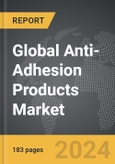The global market for Anti-Adhesion Products was valued at US$672.1 Million in 2024 and is projected to reach US$863.1 Million by 2030, growing at a CAGR of 4.3% from 2024 to 2030. This comprehensive report provides an in-depth analysis of market trends, drivers, and forecasts, helping you make informed business decisions.
One of the notable trends in the anti-adhesion products market is the continuous advancement in product formulations and delivery methods. Innovations in bioresorbable materials have led to the development of products that are both effective and safe, gradually degrading within the body after serving their purpose. Researchers and manufacturers are focusing on enhancing the efficacy of these products by improving their biocompatibility and ease of application during surgery. Moreover, the increasing adoption of minimally invasive surgical techniques has spurred the demand for anti-adhesion products compatible with laparoscopic procedures. These minimally invasive methods require specialized anti-adhesion solutions that can be easily deployed through small incisions. Additionally, there is a growing emphasis on conducting rigorous clinical trials to validate the safety and effectiveness of new anti-adhesion products, ensuring they meet regulatory standards and provide reliable outcomes for patients.
Anti-adhesion products are vital in surgical procedures to prevent post-operative adhesions, which are bands of scar tissue that can form between internal organs and tissues following surgery. These adhesions can cause severe complications, including chronic pain, bowel obstruction, and infertility, necessitating further surgical interventions. Anti-adhesion products are designed to act as barriers or gels, which are applied during surgery to prevent the formation of these adhesions. These products come in various forms, such as films, gels, and liquids, and are made from materials like hyaluronic acid, polyethylene glycol, and carboxymethylcellulose. They work by creating a physical barrier that separates tissues and organs during the critical healing period, reducing the likelihood of adhesion formation. The adoption of anti-adhesion products is particularly significant in abdominal, pelvic, and cardiac surgeries, where the risk of adhesions is high.
Anti-Adhesion Products - Key Trends and Drivers
The growth in the anti-adhesion products market is driven by several factors, including technological advancements in product development, the rising number of surgical procedures worldwide, and increasing awareness about post-surgical complications. Technological advancements have led to the creation of more effective and user-friendly anti-adhesion products, which enhance surgical outcomes and reduce the incidence of adhesions. The global increase in surgical procedures, driven by an aging population and a rise in conditions requiring surgical intervention, has significantly boosted the demand for these products. Additionally, growing awareness among healthcare professionals and patients about the risks associated with post-operative adhesions has led to higher adoption rates of anti-adhesion products. Government initiatives and healthcare policies promoting the use of advanced surgical products to improve patient outcomes also play a crucial role in market growth. Furthermore, strategic collaborations and partnerships among key market players are fostering innovation and expanding the availability of anti-adhesion products across different regions. These factors collectively propel the anti-adhesion products market towards sustained growth and innovation, ensuring better patient care and surgical outcomes.One of the notable trends in the anti-adhesion products market is the continuous advancement in product formulations and delivery methods. Innovations in bioresorbable materials have led to the development of products that are both effective and safe, gradually degrading within the body after serving their purpose. Researchers and manufacturers are focusing on enhancing the efficacy of these products by improving their biocompatibility and ease of application during surgery. Moreover, the increasing adoption of minimally invasive surgical techniques has spurred the demand for anti-adhesion products compatible with laparoscopic procedures. These minimally invasive methods require specialized anti-adhesion solutions that can be easily deployed through small incisions. Additionally, there is a growing emphasis on conducting rigorous clinical trials to validate the safety and effectiveness of new anti-adhesion products, ensuring they meet regulatory standards and provide reliable outcomes for patients.
Anti-adhesion products are vital in surgical procedures to prevent post-operative adhesions, which are bands of scar tissue that can form between internal organs and tissues following surgery. These adhesions can cause severe complications, including chronic pain, bowel obstruction, and infertility, necessitating further surgical interventions. Anti-adhesion products are designed to act as barriers or gels, which are applied during surgery to prevent the formation of these adhesions. These products come in various forms, such as films, gels, and liquids, and are made from materials like hyaluronic acid, polyethylene glycol, and carboxymethylcellulose. They work by creating a physical barrier that separates tissues and organs during the critical healing period, reducing the likelihood of adhesion formation. The adoption of anti-adhesion products is particularly significant in abdominal, pelvic, and cardiac surgeries, where the risk of adhesions is high.
Report Scope
The report analyzes the Anti-Adhesion Products market, presented in terms of market value (USD). The analysis covers the key segments and geographic regions outlined below.Segments
Type (Synthetic, Natural); Formulation (Film, Gel, Liquid); Application (General / Abdominal Surgery, Gynecological Surgery, Other Applications).Geographic Regions/Countries
World; United States; Canada; Japan; China; Europe (France; Germany; Italy; United Kingdom; Spain; Russia; and Rest of Europe); Asia-Pacific (Australia; India; South Korea; and Rest of Asia-Pacific); Latin America (Argentina; Brazil; Mexico; and Rest of Latin America); Middle East (Iran; Israel; Saudi Arabia; United Arab Emirates; and Rest of Middle East); and Africa.Key Insights:
- Market Growth: Understand the significant growth trajectory of the Synthetic Anti-Adhesion Products segment, which is expected to reach US$499.7 Million by 2030 with a CAGR of a 5.1%. The Natural Anti-Adhesion Products segment is also set to grow at 3.2% CAGR over the analysis period.
- Regional Analysis: Gain insights into the U.S. market, valued at $179 Million in 2024, and China, forecasted to grow at an impressive 7.4% CAGR to reach $185 Million by 2030. Discover growth trends in other key regions, including Japan, Canada, Germany, and the Asia-Pacific.
Why You Should Buy This Report:
- Detailed Market Analysis: Access a thorough analysis of the Global Anti-Adhesion Products Market, covering all major geographic regions and market segments.
- Competitive Insights: Get an overview of the competitive landscape, including the market presence of major players across different geographies.
- Future Trends and Drivers: Understand the key trends and drivers shaping the future of the Global Anti-Adhesion Products Market.
- Actionable Insights: Benefit from actionable insights that can help you identify new revenue opportunities and make strategic business decisions.
Key Questions Answered:
- How is the Global Anti-Adhesion Products Market expected to evolve by 2030?
- What are the main drivers and restraints affecting the market?
- Which market segments will grow the most over the forecast period?
- How will market shares for different regions and segments change by 2030?
- Who are the leading players in the market, and what are their prospects?
Report Features:
- Comprehensive Market Data: Independent analysis of annual sales and market forecasts in US$ Million from 2024 to 2030.
- In-Depth Regional Analysis: Detailed insights into key markets, including the U.S., China, Japan, Canada, Europe, Asia-Pacific, Latin America, Middle East, and Africa.
- Company Profiles: Coverage of players such as Anika Therapeutics, Inc., Baxter International Inc., Ethicon Inc., FzioMed, Inc., Integra LifeSciences Holdings Corporation and more.
- Complimentary Updates: Receive free report updates for one year to keep you informed of the latest market developments.
Some of the 21 companies featured in this Anti-Adhesion Products market report include:
- Anika Therapeutics, Inc.
- Baxter International Inc.
- Ethicon Inc.
- FzioMed, Inc.
- Integra LifeSciences Holdings Corporation
- Magen OrthoMed Ltd.
- MAST Biosurgery AG
- Sanofi SA
Table of Contents
I. METHODOLOGYII. EXECUTIVE SUMMARY2. FOCUS ON SELECT PLAYERSIII. MARKET ANALYSISCANADAITALYSPAINRUSSIAREST OF EUROPESOUTH KOREAREST OF ASIA-PACIFICARGENTINABRAZILMEXICOREST OF LATIN AMERICAIRANISRAELSAUDI ARABIAUNITED ARAB EMIRATESREST OF MIDDLE EASTIV. COMPETITION
1. MARKET OVERVIEW
3. MARKET TRENDS & DRIVERS
4. GLOBAL MARKET PERSPECTIVE
UNITED STATES
JAPAN
CHINA
EUROPE
FRANCE
GERMANY
UNITED KINGDOM
ASIA-PACIFIC
AUSTRALIA
INDIA
LATIN AMERICA
MIDDLE EAST
AFRICA
Companies Mentioned (Partial List)
A selection of companies mentioned in this report includes, but is not limited to:
- Anika Therapeutics, Inc.
- Baxter International Inc.
- Ethicon Inc.
- FzioMed, Inc.
- Integra LifeSciences Holdings Corporation
- Magen OrthoMed Ltd.
- MAST Biosurgery AG
- Sanofi SA
Table Information
| Report Attribute | Details |
|---|---|
| No. of Pages | 183 |
| Published | February 2025 |
| Forecast Period | 2024 - 2030 |
| Estimated Market Value ( USD | $ 672.1 Million |
| Forecasted Market Value ( USD | $ 863.1 Million |
| Compound Annual Growth Rate | 4.3% |
| Regions Covered | Global |









